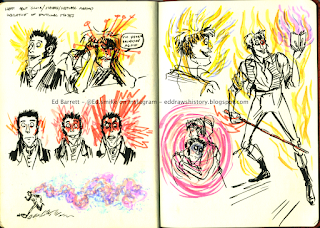The first in the SB (small book) series! I like to use several sketchbooks at the same time. If I'm working on a load of stuff in one of them (such as responding to things I'm reading, or doing a load of images for a publication that need to be batched together) then I don't want to interrupt that with something else that needs to go straight into a sketchbook. Also, they can 'talk' to each other, rather than just having a linear chronology of them. Sometimes I like doing things on different sizes of paper, so I use different sized sketchbooks.
(Timelapse video of this one here!)
There's a lot of character design stuff in this one.
 |
| Planetary stuff with Bridget and William. (See this post about IBB for some context about how I'm using planetary correspondences in interpretation/ character design.) I thought Bridget would be more solar (associated with power, responsibility, generosity, health, friendship, and other things that would be useful skills in efficiently running an extended household, while also suggesting that she is bright and lively but we don't know much about her!) and I had William down as lunar (quiet, thoughtful, secretive, rarely seen sometimes) but then I later decided that he's much more Saturnine. |
 |
| Developing William and Charley using contrasting contemporary concepts. I aligned William with the Enlightenment and with William Blake's ideas about Reason, and I associated Charley with Romanticism and Blake's ideas about the Imagination. Also I noticed (through observation and doing a bit of presenting) that lecturers and people in similar occupations usually move in a specific way: the elbows-in people take up less space and move their arms from the elbow down (this is the more common way of doing it) while the elbows-out people move much more dynamically (this is the group I fall into). I use this when I draw William and Charley teaching. |
 |
| Using William and Charley's body shapes to explore potential power dynamics. William is at the top of the hierarchy at Bowes Academy, but he's small and skinny. Charley is second in command, but much bigger and more muscular. |
 |
| I've also got loads of notes from books I'd read. Here's some from Romantics: Their Lives, Works and Inspiration (edited by Nathaniel Harris, published by Marshall Cavendish Books Ltd, London, 1991) - I used some of the poets' portraits to develop Charley's clothing, specifically his relaxed attitude to neckwear. |
 |
| I also used contemporary concepts (specifically Beauty and Sublimity, as described by Edmund Burke) in developing Ann and Charley. There aren't many traces of Ann's life left (parish records, censuses, the Mackay family bible, that's about it), certainly fewer than her husband Charley (the same things as Ann plus his adverts when he ran his own school, and newspaper reports about the ophthalmia trials), so I wanted her to seem very interesting and the sort of person you might want to be friends with - and then hopefully my poor audience feels frustrated that we know so little about her! |
 |
| So I aligned Ann with the concept of Beauty, and Charley with Sublimity. Burke says that Beauty "inspire[s] sentiments of tenderness and affection" while the Sublime surprises and scares people (while not necessarily being actually dangerous). But this sort of thing got problematic - I wanted to make my audience think that Ann and Bridget were more preferable to their schoolmaster husbands, so I made them too nice and not complex enough, which made them a bit one-sided compared to Charley and William. So I need to develop them further! (Likely postdoctorally now.) |
I also looked at contemporary educational materials - I'd picked up an undated copy of Vyse's
New London Spelling Book at a car boot sale for £2 - it first came out in the 1770s, and is the sort of thing that William and Charley would have used to teach the boys. It's full of all this moralising instructive stuff. Here's
a copy from 1813 (which resembles my undated copy), and here's
a highlight story thing on my Instagram in which I explore my copy and explain some of its weirdness.
 |
| Some of the drawings are directly relevant to my case study, like the trial, but others are silly/ metaphorical. It's useful to look at the sort of things the people in your case study might've used, even if you can't draw a direct link - it's still stuff they'd have been familiar with. In addition to Vyse, some of the 'advice' on these pages also appears in this book. |
Another experimental thing - using colour/ scribbles to explore/ suggest emotional states. Can I communicate vibes without words?
Then more trying to capture/ evoke/ communicate moods without words. These are the final two spreads in the book. I can't remember if I was experiencing any (worse than usual) psychological disturbances when I drew these - quite often, when I have those, I draw William and he gets it too. Sometimes these drawings are the only trace of those experiences. Everything that happens to me becomes material that I can use! (I'm secretly an optimist)
I think I might've been overwhelmed by something (or a mass of somethings) so I wondered whether William might have felt overwhelmed by all his responsibilities. Genuinely can't remember!
















No comments:
Post a Comment